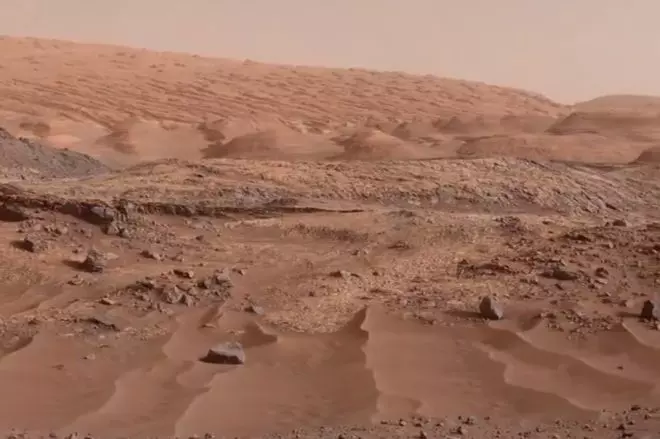El viento que sopla sobre la superficie desértica de Marte: el vídeo del Curiosity en el planeta que se ha hecho viral

En algunas ocasiones, unas simples imágenes pueden levantar más interés que cualquier acontecimiento; sobre todo, si proceden de otros planetas diferentes al nuestro. La cuenta de Twitter @wonderofscience ha publicado un vídeo enviado por el Curiosity, el robot enviado por la NASA a Marte.
The surface of Mars as seen by Curiosity Rover with the sound of the Martian winds captured by InSight lander. Credit: NASA/JPL-Caltech/MSSS pic.twitter.com/Qseu1wxQCs
— Wonder of Science (@wonderofscience) February 5, 2021
En el vídeo se puede apreciar la superficie desértica y el viento del planeta rojo. No obstante, el Curiosity no ha parado de enviar imágenes inéditas desde que pisó Marte por primera vez en 2012.
The surface of Mars captured by NASA's Curiosity rover.???????? pic.twitter.com/DbEHUwkjjk
— venus ????♀️ (@venus47203379) February 5, 2021
This #BurnsDay, I'm singing Auld Lang Syne for recent science targets with "Scottish" names. "French" sites are keeping me très occupée, and will for many sols to come. My team nicknames all the spots I visit, and each quadrant has a different theme. Blog: https://t.co/zxs5zQETrv pic.twitter.com/t8cx9QzBCm
— Curiosity Rover (@MarsCuriosity) January 25, 2021
You know how to make a rover feel loved! ♥️ Thank you all for the kind thoughts.
While I may not hum "Happy Birthday" to myself anymore (only did that once back in 2013), I *am* baking up some sweet science with my SAM instrument. https://t.co/hJrvtFZVgn pic.twitter.com/N1cRFbzSCX
— Curiosity Rover (@MarsCuriosity) August 5, 2020
Just keep roving, roving, roving. I'm on a mile-long quest around deep sand to study a part of Mount Sharp called the "sulfate-bearing unit." It may give more clues how climate on Mars and its prospects for life changed nearly 3 billion years ago. https://t.co/VN9V4rjItI pic.twitter.com/ljHfxEQ1Pj
— Curiosity Rover (@MarsCuriosity) July 6, 2020
At sunset. The sunsets on Mars are blue. It has to do with the size of the dust particles in the atmosphere and how they scatter light. Check it out! https://t.co/JSp5xvbUVk pic.twitter.com/NX4hu8mV18
— Curiosity Rover (@MarsCuriosity) March 10, 2020
Incluso atreviéndose con algún que otro selfie.
Look cute – and I won't delete later.
Greetings from the Red Planet! I took another selfie as I explored a new spot dubbed "Mary Anning," where I'm analyzing drill samples. I conducted experiments on them in my continued search for organic molecules. https://t.co/NKTjxVNjX7 pic.twitter.com/GynSQifLQC
— Curiosity Rover (@MarsCuriosity) November 12, 2020
No doubt. pic.twitter.com/6MoyalEwJM
— Curiosity Rover (@MarsCuriosity) January 31, 2020
Y es que es indudable que vernos desde otro planeta nos recuerda el pequeño hueco que ocupamos en el universo.
You said it, @NASAMars. For perspective, here's what Earth looks like from the surface of Mars. Shine on! pic.twitter.com/jn0egTQG72
— Curiosity Rover (@MarsCuriosity) December 21, 2020






Comentarios
<% if(canWriteComments) { %> <% } %>Comentarios:
<% if(_.allKeys(comments).length > 0) { %> <% _.each(comments, function(comment) { %>-
<% if(comment.user.image) { %>
![<%= comment.user.username %>]() <% } else { %>
<%= comment.user.firstLetter %>
<% } %>
<% } else { %>
<%= comment.user.firstLetter %>
<% } %>
<%= comment.user.username %>
<%= comment.published %>
<%= comment.dateTime %>
<%= comment.text %>
Responder
<% if(_.allKeys(comment.children.models).length > 0) { %>
<% }); %>
<% } else { %>
- No hay comentarios para esta noticia.
<% } %>
Mostrar más comentarios<% _.each(comment.children.models, function(children) { %> <% children = children.toJSON() %>-
<% if(children.user.image) { %>
![<%= children.user.username %>]() <% } else { %>
<%= children.user.firstLetter %>
<% } %>
<% } else { %>
<%= children.user.firstLetter %>
<% } %>
<% if(children.parent.id != comment.id) { %>
en respuesta a <%= children.parent.username %>
<% } %>
<%= children.user.username %>
<%= children.published %>
<%= children.dateTime %>
<%= children.text %>
Responder
<% }); %>
<% } %> <% if(canWriteComments) { %> <% } %>